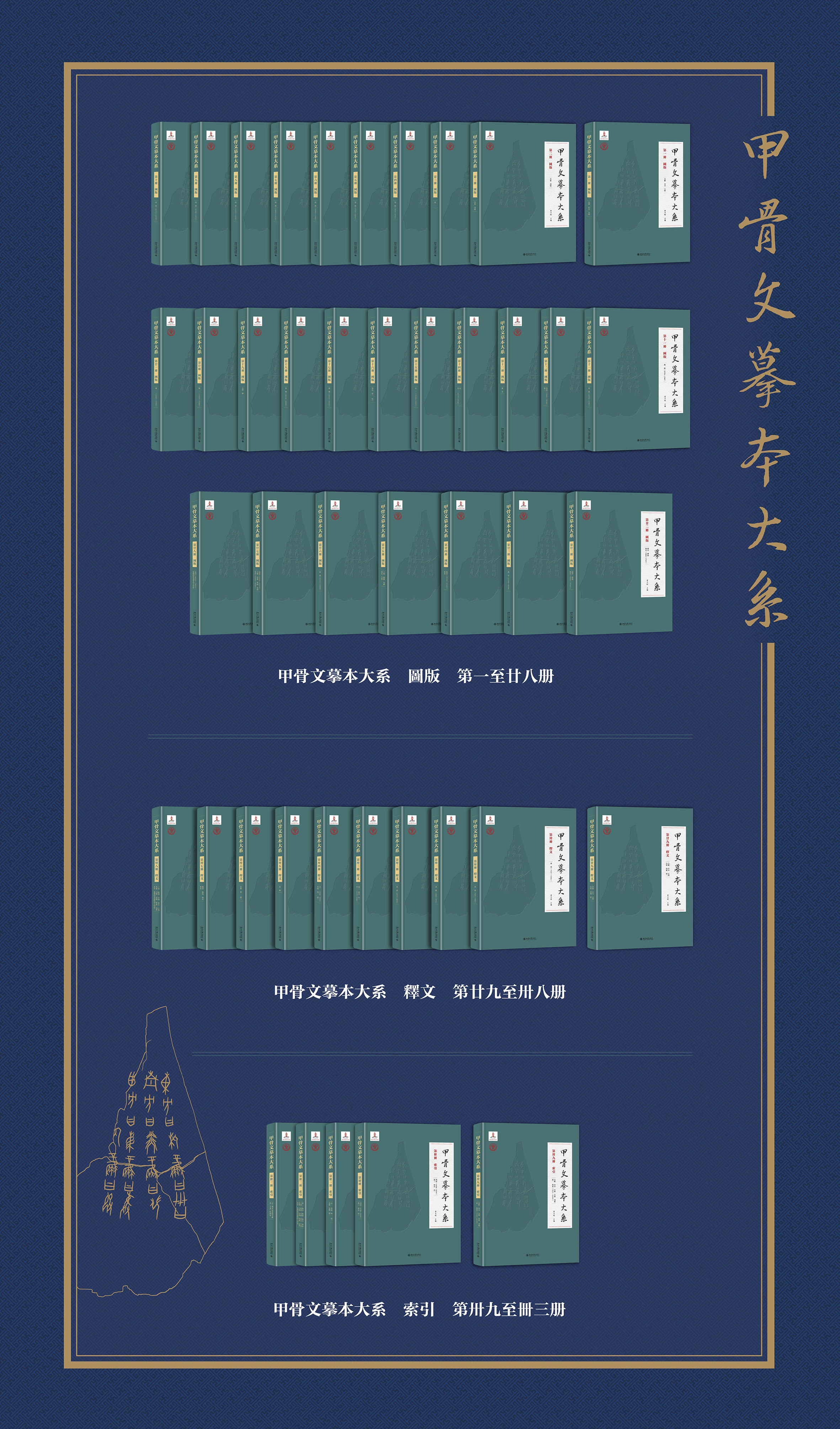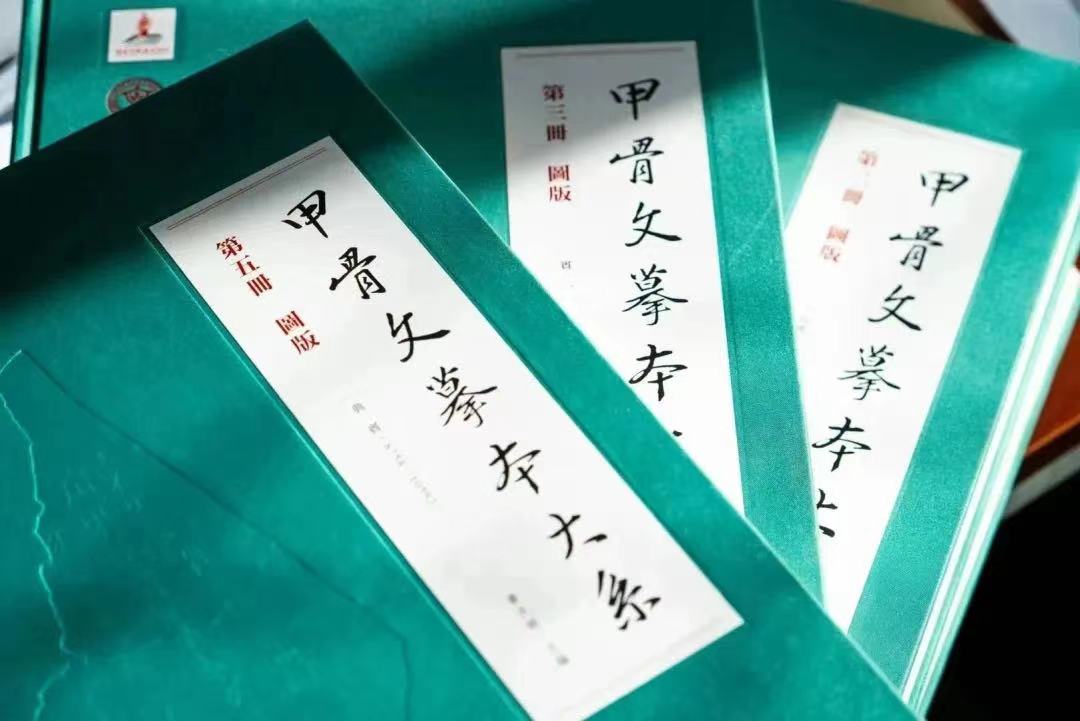On the morning of 18 December, the Tsinghua University Research and Conservation Center for Unearthed Texts, Peking University Press, and XuetangX collaborated to host an online book launch for Compendium of Oracle Bone Tracings simultaneously broadcasted across the globe. Including famous scholars at home and abroad, more than thirty-five thousand people attended the book launch online.


The book launch was composed of two parts. The first part was chaired by Professor Huang Dekuan, Director of the Tsinghua University Research and Conservation Center for Unearthed Texts. Tian Lixin, director-general of the Ministry of Education’s Language and Information directorate, Professor Peng Gang, vice-President of Tsinghua University, Senior Professor Lin Yun of Jilin University, Ma Jianjun, chairman of Peking University Press, delivered speeches. They congratulated Professor Huang Tianshu and his research team for their compilation and publication of Compendium of Oracle Bone Tracings.
Director-general Tian Lixin rated the scholarly value of Compendium of Oracle Bone Tracings very highly, noting that this big study is “a comprehensive edition of oracle bone inscriptions and an important trademark publication for the Paleography Program. It is also the best gift to present on the 3rd anniversary of General Secretary Xi Jinping’s congratulatory letter on the 120th anniversary of the discovery and research of oracle bone inscriptions. Director-general Tian Lixin finally shared three observations to encourage the participants of the book launch.
Vice-President Peng Gang started his speech from the tradition of oracle bone scholarship at Tsinghua University, and noted that the publication of Compendium of Oracle Bone Tracings “can be seen as the continuation of this glorious Tsinghua tradition in the new era,” it is “yet another publication with extreme indicative value.” He further expressed that the university would keep giving the Center for Unearthed Texts its highest support, and the hope that Professor Huang Tianshu and his team continue to produce more such excellent scholarship.
Chairman Ma Jianjun called the publication of Compendium of Oracle Bone Tracings a major affair in the study of Chinese characters and the world of publishing. Chairman Ma looked back on the close cooperation between the editing team and the authors, and the precise and exacting publishing process, showing the hardship and difficulties in publishing a reference work for oracle bone scholarship.
Professor Lin Yun, as one of the recommending scholars for Compendium of Oracle Bone Tracings, was filled with happiness in his address. Professor Lin noted that he floated the idea of re-editing oracle bones along the “north-south” theory a long time ago, and that the publication of Compendium is a great convenience to the field and is a major affair that paleographers should warmly congratulate.
Professor at the Tsinghua University Research and Conservation Center for Unearthed Texts and chief editor of Compendium of Oracle Bone Tracings professor Huang Tianshu presented in lieu of his team. He succinctly introduced the compilation, background, scholarly goals, principles of organization, and the scholarly innovation of Compendium of Oracle Bone Tracings, so that the field has a clearer understanding of its merits.
The second part of the book launch was chaired by Professor Liu Guozhong, vice-director of the Tsinghua University Research and Conservation Center for Unearthed Texts. Research Fellow Liu Yiman of Chinese Academy of Social Sciences, Peking University Boya Chair Professor Zhu Fenghan, Chair of the Society for Chinese Paleography, Professor Wu Zhenwu of Jilin University, Director of the Fudan University Center for Chinese Excavated Classics and Paleography, Professor Liu Zhao, Professor Dong Shan of Peking University, Professor Jiang Yubin of the Fudan University Center for Chinese Excavated Classics and Paleography and Professor Zhou Zhongbing of Jilin University gave excellent presentations. They gave a very positive evaluation of the scholarly contributions of Compendium of Oracle Bone Tracings.
Professor Liu Yiman noted that Compendium for Oracle Bone Tracings has paved a new way to organize a collection of oracle bones, the publication of this book will “raise the study of oracle bone inscriptions and the history of the Shang dynasty to a new level.” Professor Zhu Fenghan talked about four strengths of Compendium for Oracle Bone Tracings, noting that the publication of the book “makes extensive research into oracle bone inscriptions, their division and periodization, the transcription of the graphs, and the study of Shang history much more convenient for scholars.”
Professor Wu Zhenwu called the book “a milestone publication in the study of oracle bones,” its use in paleography and ancient history research will gradually become apparent. Professor Liu Zhao used the metaphor of forging a sword to laud the craftsmanship of professor Huang Tianshu and his team, he referred to the book as “representing oracle bone inscription scholarship of the highest level and the direction for oracle bone scholarship,” “it is a milestone handbook.”
Professor Dong Shan named Compendium of Oracle Bone Tracings together with Collection of Oracle Bone Inscriptions as the two greatest achievements in the 120 years of oracle bone scholarship, and discussed several new directions of oracle bone scholarship to inspire scholarship. Professor Jiang Yubin spoke of the scholarly value of Compendium of Oracle Bone Tracings from the point of view of compiling a collection. He referred to Compendium as “an example of careful editing of oracle bone inscriptions, a foundation for a scholarly oracle bone inscription collection.” Professor Zhou Zhongbing, in turn, carefully described the history of over a hundred years of oracle bone collection and compilation to the audience.
Finally, Professor Liu Guozhong summarized the second part’s forum discussion.
Compendium of Oracle Bone Tracings is the first of the large compendia of written oracle bone materials that uses tracings to present the source material and comprehensively organizes and studies the material based on the latest theoretical and methodological advances. It reorganizes the “vast, messy, and unorganized” state of the more than 70,000 published oracle bone inscriptions into a well-ordered set of primary sources. The whole book consists of 43 volumes, divided into three sections: “Images” (28 volumes), “Transcriptions” (10 volumes), and “Index” (5 volumes). Printed on B3 paper, it collects 70,659 oracle bones. Compendium of Oracle Bone Tracings is the largest collection of oracle bone inscriptions to date.
From 2012 to 2022, Professor Huang Tianshu led his team of oracle bone scholars to compile Compendium, their work consisted of: selecting quality rubbings, excising forgeries, deleting doubles, rejoining fragments, organizing and dividing by period, producing the tracings, writing the transcriptions, and creating the index. After ten years of work it’s now finally finished, it can truly be called “Taking ten years to sharpen a sword.”
Compared with other large collections such as the Collection of Oracle Bone Inscriptions, Compendium of Oracle Bone Tracings has the following qualities: 1) The book uses advances a new framework for compiling oracle bones by using the new “north-south” theory instead of the older “five-period” dating theory to organizing the more than 70,000 oracle bone pieces. When Dong Zuobin originated the five-period theory, it was both incisive and highly significant. But its problem is that it mixed script types with the periodization of the lineages of the royal house. Now oracle bone scholars realize that the division into script-types of the inscriptions and periodization are two separate steps. We should first categorize the inscriptions based on script characteristics, and only then determine to which period these script-types belong. This is a great development in the theory and method of oracle bone periodization. Collection of Oracle Bone Inscriptions edited by Guo Moruo was compiled based on Dong Zuobin’s five-period theory, and can no longer meet the needs of the age. That is why the compilation of a large collection of oracle bones along Li Xueqin’s north-south theory is so important to oracle bone scholars. Now we present Compendium of Oracle Bone Tracings to the academic community, which is completely organized around script-style, and will bring the study of oracle bone inscriptions to a higher level.
2) Careful traces for every inscribed oracle bone. As cherished cultural artefacts, actual oracle bones are hard to access for scholars. As a result, the study of oracle bones has predominantly based itself on publications of rubbings, pictures, and tracings. All three forms have their relative advantages and can be used to compensate for each other’s disadvantages. With high quality tracings of the oracle bone, an in-depth visual presentation of a range of scholarly information useful to the beginning scholar of oracle bones can be provided.
3) Provide a script-type categorization for all oracle bones with writing. The oracle bone inscriptions from Yin Ruins are the earliest written sources for ancient Chinese. But in order to use oracle bone inscriptions as a source for language study, their dating needs to be clarified. If not, the more than 100,000 oracle bones are still not more than “fragmented and corrupt court reports” and have limited scholarly value. Establishing the division by script types, implies a basic premise for the deduction of their date and thus greatly increases their value as historical source materials. The categorization of script types has seen the most advances in the study of periodization over the last couple of decades and is used in all aspects of oracle bone scholarship; it has opened a new direction for oracle bone scholarship.
4) Gathering oracle bones and rejoining new materials. Compendium of Oracle Bone Tracings is the largest collection of oracle bones to date. For over twenty years, there have been many advances in the rejoining of oracle bone fragments, with over 3000 groups rejoined. Some of these rejoined fragments are extremely important and have provided hitherto unseen sources that have enriched immensely scholarly understanding of Shang dynasty society. Nevertheless, these rejoined fragments were spread over a vast array of books, articles, and academic websites, and were therefore inconvenient to use. Compendium has collected all rejoined fragments from before December 2020, and thus greatly decreased the efforts required by scholars to locate them.
5) Writing the transcriptions, creating the index. When readers want to find a corresponding rubbing, they can find it easily and quickly using Compendium’s index.
General Secretary Xi Jinping has said, the oracle bone inscriptions discovered at Yin Ruins are 3,000 years removed from us, in those 3,000 years, the structure of Chinese characters has not changed, this inheritance is the true DNA of the Chinese nation. In 2019 on the 120th anniversary of the discovery and research of oracle bone inscriptions, Xi has sent a congratulatory letter.
The discovery of the oracle bone inscriptions from Yin Ruins is of epoch-making significance in Chinese civilization and even human civilization, Xi said.
Oracle bone inscriptions are considered the origin of Chinese characters and represent the oldest fully-developed system of characters discovered in China so far.
Xi described oracle bone inscriptions as the roots of fine traditional Chinese culture that merits even better preservation and development.
The compilation of Compendium of Oracle Bone Tracings carries out the important initiative of General Secretary Xi Jinping’s speech, and is sure to leave a strong impression in the history of oracle bone scholarship.
Editor: Li Han

